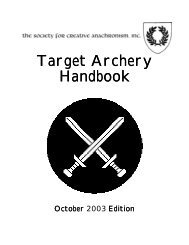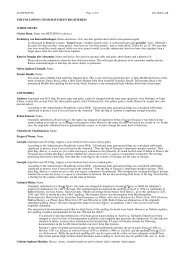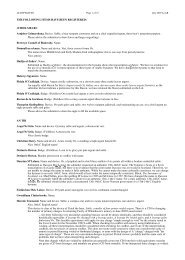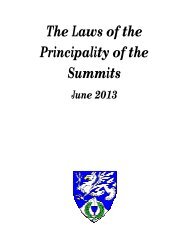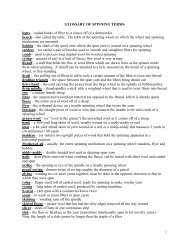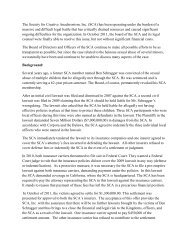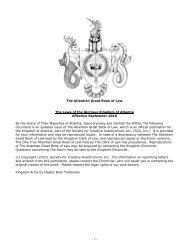The Standards for Evaluation of Names and Armory - SCA Heraldry
The Standards for Evaluation of Names and Armory - SCA Heraldry
The Standards for Evaluation of Names and Armory - SCA Heraldry
Create successful ePaper yourself
Turn your PDF publications into a flip-book with our unique Google optimized e-Paper software.
<strong>The</strong> <strong>St<strong>and</strong>ards</strong> <strong>for</strong> <strong>Evaluation</strong> <strong>of</strong> <strong>Names</strong> <strong>and</strong> <strong>Armory</strong>:<strong>The</strong> Rules <strong>for</strong> Submissions4. Excessive Counterchanging: While counterchanging was common in period armory, it was used mainlywith two or four part divisions <strong>of</strong> the field. Counterchanging <strong>of</strong> charges over more complex field divisions(barry, gyronny, etc.) is allowed with a semy or similar group <strong>of</strong> charges; in that design each charge shouldbe drawn so that it is entirely on a single portion <strong>of</strong> the field. <strong>The</strong> counterchanging <strong>of</strong> a single charge over afield division with more than four sections must be attested to be allowed. Central ordinaries may becounterchanged over other simple ordinaries, as there are a few examples <strong>of</strong> patterns like Argent, a pilesable, overall a chevron counterchanged in late period Engl<strong>and</strong>. Any other counterchanging <strong>of</strong> chargesover other charges must similarly be attested to be registered.5. Depictions Which Cannot Be Reproduced Reliably: Depictions that require the careful description <strong>of</strong> therelative positions <strong>of</strong> charges, tinctures, etc. in order to produce a visual effect cannot be registered. Designsmust be able to be described in st<strong>and</strong>ard heraldic terms to be registerable.For example, we do not use terms like the Victorian honor point to describe locations on the field. We donot have terms to describe the tinctures <strong>of</strong> a jester's hat in which each point is a different color.A.4. <strong>Armory</strong> Individually Attested PatternsA. Definitions: Any armorial design that does not fit within our core style rules may still be registered if it can bedocumented as following a pattern <strong>of</strong> period practice within the armorial style <strong>of</strong> a single time <strong>and</strong> placewithin the temporal scope <strong>of</strong> the Society. This time <strong>and</strong> place may be in Europe or may be from a non-European period armorial tradition, such as Islamic or Japanese heraldry. We call such a design anIndividually Attested Pattern. All elements in an Individually Attested Pattern must be found in that singletime <strong>and</strong> place, including charges, arrangement <strong>of</strong> charge groups, <strong>and</strong> lines <strong>of</strong> division. Documentation underthe Individually Attested Pattern rules does not exempt a design from conflict, presumption, or <strong>of</strong>fense rules.For example, Sable, a torii gate Or between three panthers argent, spotted <strong>of</strong> many tinctures would not beregisterable as an Individually Attested Pattern, as it mixes charges from both Japan <strong>and</strong> Engl<strong>and</strong>.Any submissions documented under this section <strong>of</strong> the rules must be able to have the overall design blazonedin Western European blazon, including tinctures. If necessary, when there is no Western European term <strong>for</strong> acharge, a non-Western European term may be registerable on a case by case basis, presuming that a term canbe found which will allow reproduction from the blazon. If the submission is not otherwise blazonablewithout creating or borrowing terms that cannot be easily understood by the average herald, the submissionwill not be registered.For example, we will not use the blazon terms dark or light; we require a Japanese design to use st<strong>and</strong>ardEuropean tinctures. A so-called cross Osmorog will be blazoned as a cross fourchy between the tines <strong>of</strong> each<strong>for</strong>k a roundel argent, as this is the blazon we have already used <strong>for</strong> this charge. We will register anarrangement that would not be registerable under the core style rules, such as a roundel within roundels inannulo, but we will not create new terms to describe arrangements <strong>of</strong> charges.B. What Must Be Documented: Each element <strong>of</strong> the armory which falls outside the core style rules must bedocumented. If armory has multiple elements which fall outside the core style rules, the combination <strong>of</strong> thesenon-core style elements should be documented, although larger numbers <strong>of</strong> examples <strong>of</strong> each non-core styleelement may suffice, as described below. <strong>The</strong> overall design <strong>of</strong> the submission must be similar to the types <strong>of</strong>designs that document the use <strong>of</strong> the non-core style elements. In general, examples must match thesubmission in style <strong>and</strong> complexity.<strong>St<strong>and</strong>ards</strong> <strong>for</strong> <strong>Evaluation</strong> <strong>of</strong> <strong>Names</strong> <strong>and</strong> <strong>Armory</strong> – April 29, 2012 - Page 48 <strong>of</strong> 73



